TSB 02 157 14R Subaru engine oil consumption (PDF)
File information
This PDF 1.7 document has been generated by / Foxit Reader PDF Printer Version 6.1.0.0923, and has been sent on pdf-archive.com on 16/01/2015 at 22:59, from IP address 71.171.x.x.
The current document download page has been viewed 16006 times.
File size: 8.12 MB (26 pages).
Privacy: public file
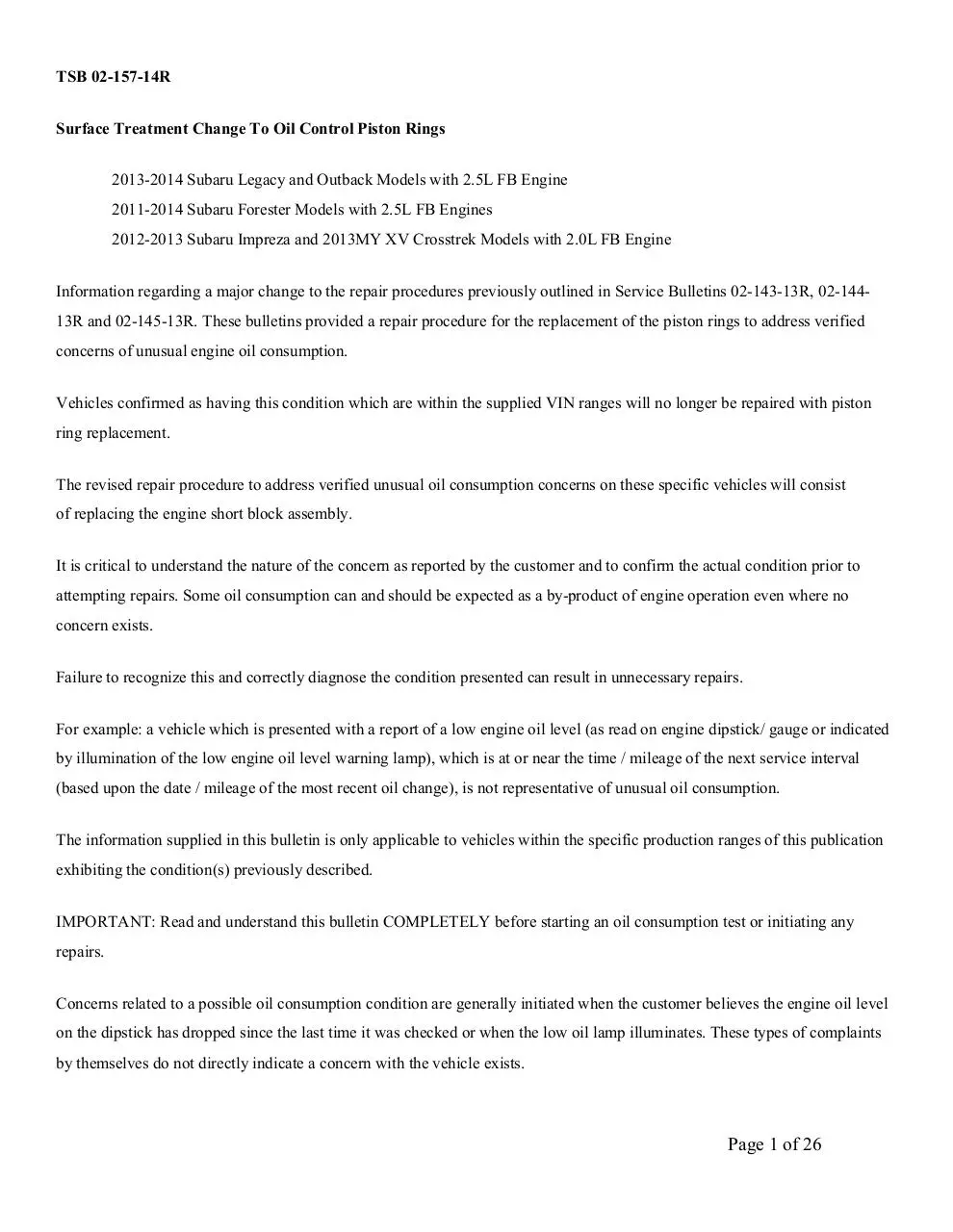

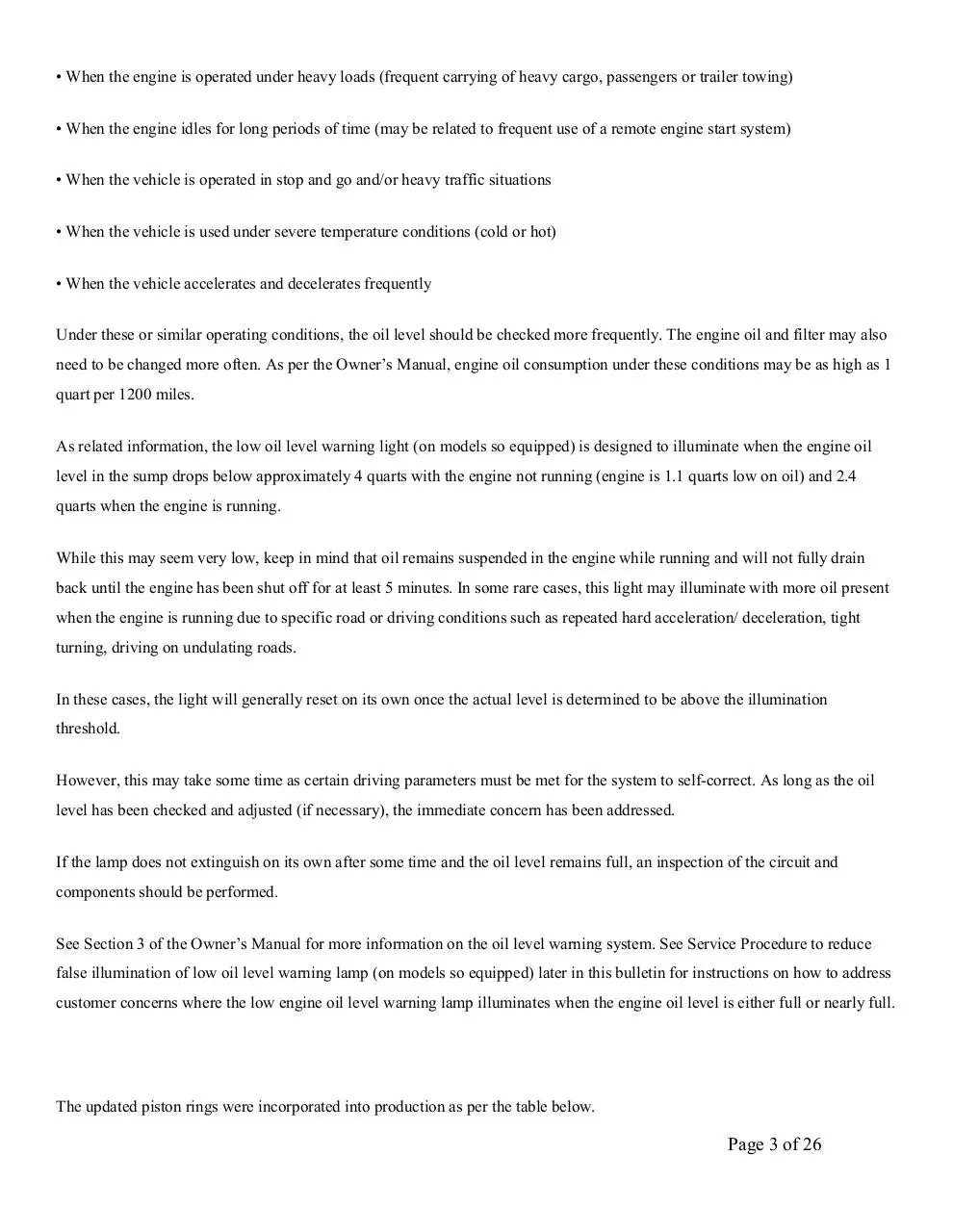
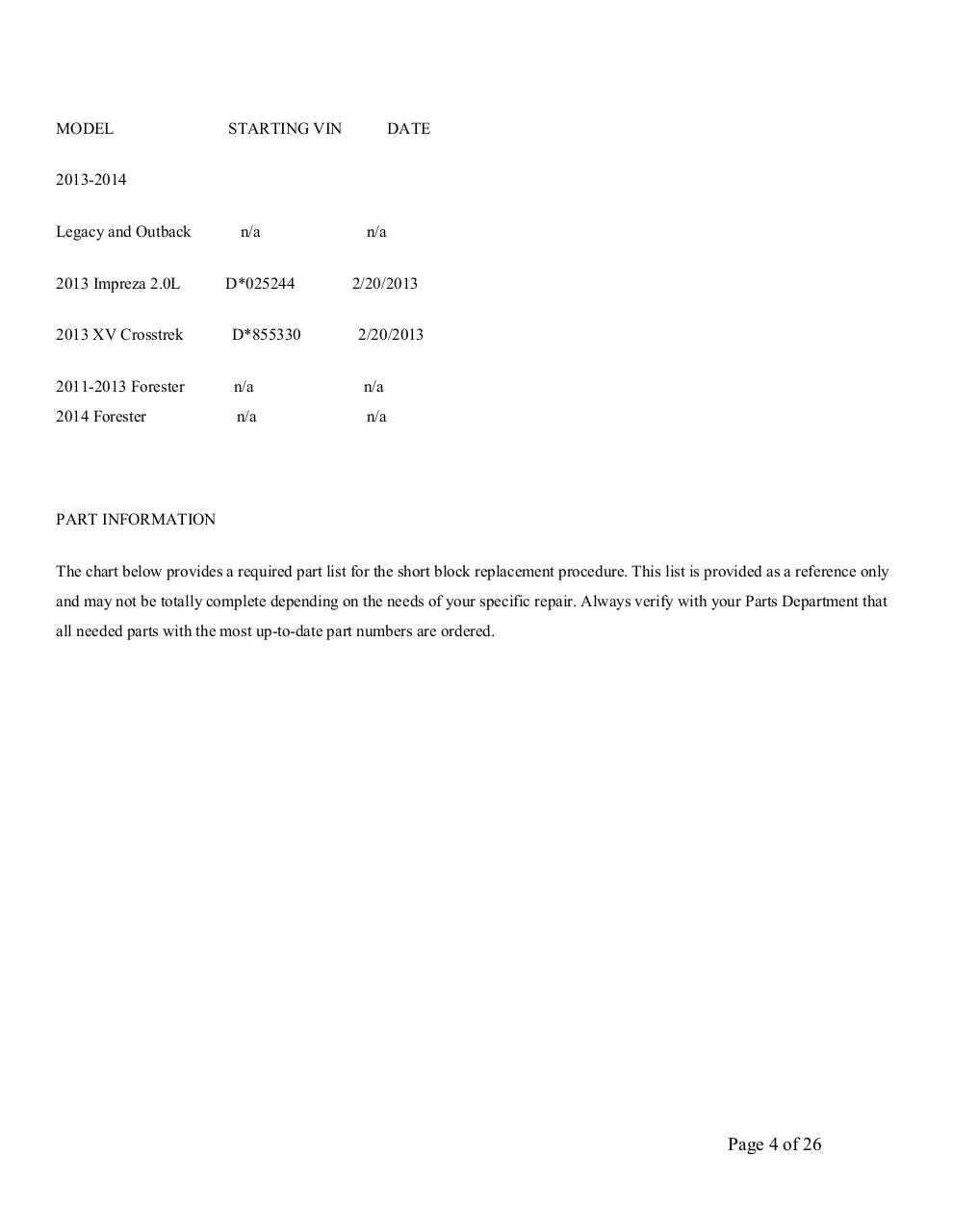
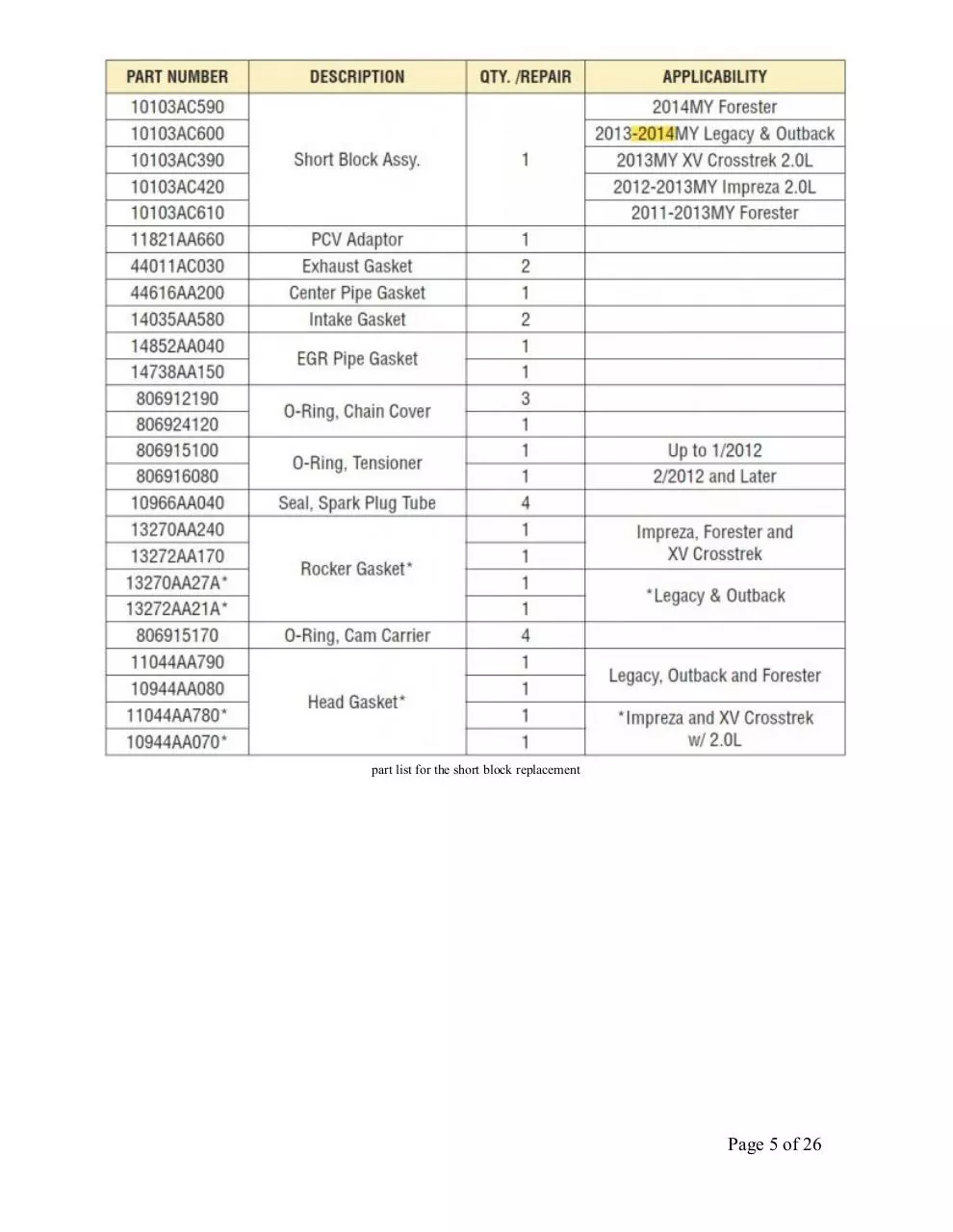
File preview
TSB 02-157-14R
Surface Treatment Change To Oil Control Piston Rings
2013-2014 Subaru Legacy and Outback Models with 2.5L FB Engine
2011-2014 Subaru Forester Models with 2.5L FB Engines
2012-2013 Subaru Impreza and 2013MY XV Crosstrek Models with 2.0L FB Engine
Information regarding a major change to the repair procedures previously outlined in Service Bulletins 02-143-13R, 02-14413R and 02-145-13R. These bulletins provided a repair procedure for the replacement of the piston rings to address verified
concerns of unusual engine oil consumption.
Vehicles confirmed as having this condition which are within the supplied VIN ranges will no longer be repaired with piston
ring replacement.
The revised repair procedure to address verified unusual oil consumption concerns on these specific vehicles will consist
of replacing the engine short block assembly.
It is critical to understand the nature of the concern as reported by the customer and to confirm the actual condition prior to
attempting repairs. Some oil consumption can and should be expected as a by-product of engine operation even where no
concern exists.
Failure to recognize this and correctly diagnose the condition presented can result in unnecessary repairs.
For example: a vehicle which is presented with a report of a low engine oil level (as read on engine dipstick/ gauge or indicated
by illumination of the low engine oil level warning lamp), which is at or near the time / mileage of the next service interval
(based upon the date / mileage of the most recent oil change), is not representative of unusual oil consumption.
The information supplied in this bulletin is only applicable to vehicles within the specific production ranges of this publication
exhibiting the condition(s) previously described.
IMPORTANT: Read and understand this bulletin COMPLETELY before starting an oil consumption test or initiating any
repairs.
Concerns related to a possible oil consumption condition are generally initiated when the customer believes the engine oil level
on the dipstick has dropped since the last time it was checked or when the low oil lamp illuminates. These types of complaints
by themselves do not directly indicate a concern with the vehicle exists.
Page 1 of 26
It is important to understand all the factors involved in order to make a sound decision regarding whether or not a repair is
required or if an oil consumption test should even be started.
When speaking with customers about a reported or suspected oil consumption concern, always keep the following in mind:
Some engine oil will always be consumed as part of normal engine operation. How much and when it is consumed varies
according to manufacturing tolerances, wear, and vehicle usage patterns.
With the extended service intervals commonly used for today’s engines combined with one or more of the conditions listed
below, typical engine oil consumption may require adding engine oil in between scheduled maintenance intervals:
• When the engine is new and within the break-in period (during the first 1000 miles of operation)
• When the engine oil being used is of lower quality (other than “Energy or Resource Conserving” API
Engine Oil
Classification SM or SN or ILSAC, look for the starburst design with GF-4 or GF-5)
• When the incorrect oil viscosity is used (viscosity other than 0W-20 in the case of these specific vehicles)
• When engine braking is employed (use of the transmission’s gear ranges to decelerate while using the engine to apply
resistance)
• When the engine is operated at high engine speeds (continually or under frequent, hard acceleration)
Page 2 of 26
• When the engine is operated under heavy loads (frequent carrying of heavy cargo, passengers or trailer towing)
• When the engine idles for long periods of time (may be related to frequent use of a remote engine start system)
• When the vehicle is operated in stop and go and/or heavy traffic situations
• When the vehicle is used under severe temperature conditions (cold or hot)
• When the vehicle accelerates and decelerates frequently
Under these or similar operating conditions, the oil level should be checked more frequently. The engine oil and filter may also
need to be changed more often. As per the Owner’s Manual, engine oil consumption under these conditions may be as high as 1
quart per 1200 miles.
As related information, the low oil level warning light (on models so equipped) is designed to illuminate when the engine oil
level in the sump drops below approximately 4 quarts with the engine not running (engine is 1.1 quarts low on oil) and 2.4
quarts when the engine is running.
While this may seem very low, keep in mind that oil remains suspended in the engine while running and will not fully drain
back until the engine has been shut off for at least 5 minutes. In some rare cases, this light may illuminate with more oil present
when the engine is running due to specific road or driving conditions such as repeated hard acceleration/ deceleration, tight
turning, driving on undulating roads.
In these cases, the light will generally reset on its own once the actual level is determined to be above the illumination
threshold.
However, this may take some time as certain driving parameters must be met for the system to self-correct. As long as the oil
level has been checked and adjusted (if necessary), the immediate concern has been addressed.
If the lamp does not extinguish on its own after some time and the oil level remains full, an inspection of the circuit and
components should be performed.
See Section 3 of the Owner’s Manual for more information on the oil level warning system. See Service Procedure to reduce
false illumination of low oil level warning lamp (on models so equipped) later in this bulletin for instructions on how to address
customer concerns where the low engine oil level warning lamp illuminates when the engine oil level is either full or nearly full.
The updated piston rings were incorporated into production as per the table below.
Page 3 of 26
MODEL
STARTING VIN
DATE
2013-2014
Legacy and Outback
2013 Impreza 2.0L
n/a
D*025244
n/a
2/20/2013
2013 XV Crosstrek
D*855330
2/20/2013
2011-2013 Forester
n/a
n/a
2014 Forester
n/a
n/a
PART INFORMATION
The chart below provides a required part list for the short block replacement procedure. This list is provided as a reference only
and may not be totally complete depending on the needs of your specific repair. Always verify with your Parts Department that
all needed parts with the most up-to-date part numbers are ordered.
Page 4 of 26
part list for the short block replacement
Page 5 of 26
part list for the short block replacement
MISCELLANEOUS MATERIALS
PART
DESCRIPTION
QUANTITY
SOA635065
ThreeBond 1280B / 1217G
1
SOA635041
Super Coolant, (qt.)
8
SOA635045
Engine Oil (qt.) 0W-20
6
SERVICE PROCEDURE / INFORMATION
Before starting any repairs, the first step is to always confirm the customer’s complaint. It is critical to get as much information
from the customer as possible to help you make the most accurate diagnosis.
• Review all the available service and repair history along with any other records the customer can provide to establish whether
or not the vehicle has been properly maintained.
• Perform a thorough visual inspection to make sure there are no external oil leaks that could be contributing to the condition.
• It is also very important to not overlook the engine’s PCV system and to confirm it is operating properly. Check the air filter
assembly and throttle body / intake manifold for any excessive oil residue which could be an indicator of a sticking or failed
PCV valve.
Page 6 of 26
NOTES:
• An oil consumption test will need to be completed to determine the proper course of action. There is a specific procedure and
Oil Consumption Test form which must be completed. See Subarunet \ Service \ Forms for the latest test form. Always print the
latest form anytime a new test is started.
• Where applicable, available reprogramming to reduce the possibility of false low engine oil level warning lamp illumination
must be installed. See Service Procedure to reduce false illumination of low oil level warning lamp (on models so equipped)
later in this bulletin for further instructions. This must be completed at either the start or end of the consumption testing
regardless of the final outcome.
IMPORTANT: At the start of the Oil Consumption Test Form, specific information regarding what prompted (reason for) the
testing must be collected. Once this questionnaire section of the form is completed, it must be faxed to 856-488-3199.
Upon completion of the actual consumption test, the remainder of the form must be completed and faxed AGAIN to 856-4883199. This information is being collected for quality assurance purposes only. You will not receive any response from
these submissions.
This is NOT an authorization process. Proceed with any necessary testing or repairs as indicated by the information provided in
this service bulletin, the Oil Consumption Test form results, Subaru’s Claims Policies and Procedures, and your evaluation of
the actual condition presented based upon your review of all three areas.
Keep in mind, these repairs should only be completed when unusual oil consumption has been confirmed.
Before initiating the consumption test, all basic checks must be completed. These include (but are not limited to): confirming
the actual oil level, noting if any oil has been added prior to this visit and how much, checking for any external leaks,
confirming PCV operation, and verifying that a consumption test has not already been started or completed previously.
Always use the latest Oil Consumption Test form form found on Subarunet in the Service Forms area. Follow the instructions
outlined on the form.
NOTE: The oil and filter change is only necessary if no prior consumption test has been completed or is already in process.
There is no need for duplicate or repeat testing.
One-time documented results are all that is required to move forward with these repairs.
Page 7 of 26
Always close the repair order on the day the oil change has been completed and submit the claim for the oil consumption test
using the coding provided at the end of this bulletin. Indicate “Oil Consumption Test” in the comments field / box when
entering your claim.
DO NOT hold the repair order open until the vehicle returns. Have the customer drive the vehicle then return for inspection
when any of the following have occurred:
• At least 1200 miles have elapsed
• When the low engine oil level warning lamp illuminates (when equipped)
• When the oil level reaches the lower hole in the dipstick/ gauge (as determined by the customer).
The customer should be advised to not add oil unless there will be a significant delay before they can return for inspection once
a low oil condition occurs. A one-time check of the oil consumption by the retailer is all that is needed to establish if the
condition outlined in this bulletin applies.
SPECIFIC SERVICE PROCEDURES
The following information is provided to underscore service procedures specific to the repairs outlined in this bulletin. They are
not meant to represent the entire repair process from start to finish.
The procedures provided here are specific to certain steps in the overall process. In some cases, they will differ greatly from the
Service Manual instructions and should be followed in place of the Service Manual for these specific areas only.
For the balance of the repair procedure, refer to the Service Manual. It is highly recommended to review all of the Service
Manual procedures for short block replacement then review these specific procedures to become familiar with the differences.
• When draining the engine oil, do not remove the engine oil filter. Leave the existing oil filter in place through engine
disassembly, reassembly, installation and initial startup after engine reassembly.
• When removing the engine, there is no need to remove the transmission case cover (CVT only) or to disconnect / disturb any
of the transmission harness connectors. While raising the transmission with the service jack placed under the front differential
as shown in the illustration below, only raise it enough to access and remove the engine mounting hardware.
Raising it too high can push the transmission up into the bulkhead / transmission tunnel and possibly cause damage.
Page 8 of 26
raising the transmission with the service jack
• When removing the CVT fluid cooler (if equipped), leave it attached to its mounting bracket and remove as an assembly (3
bolts) from the transmission. Disconnect just the engine coolant hoses from it and do not disturb the 2 short CVT fluid lines.
Hook one of the cooler’s mounting bracket “ears” behind the bulkhead harness as shown in the photo below to keep the cooler
assembly out of your way. Use a shop cloth between the “ear” and the bulkhead harness to prevent any chafing.
Page 9 of 26
Download TSB 02-157-14R Subaru engine oil consumption
TSB 02-157-14R Subaru engine oil consumption.pdf (PDF, 8.12 MB)
Download PDF
Share this file on social networks
Link to this page
Permanent link
Use the permanent link to the download page to share your document on Facebook, Twitter, LinkedIn, or directly with a contact by e-Mail, Messenger, Whatsapp, Line..
Short link
Use the short link to share your document on Twitter or by text message (SMS)
HTML Code
Copy the following HTML code to share your document on a Website or Blog
QR Code to this page
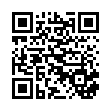
This file has been shared publicly by a user of PDF Archive.
Document ID: 0000204238.